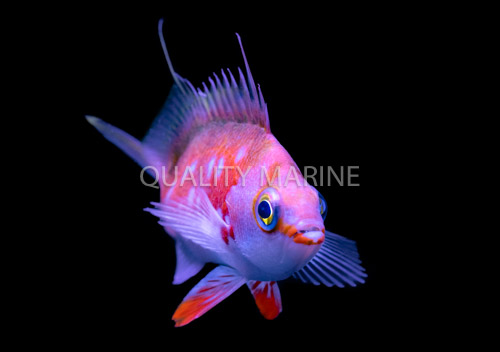Cheer up Your Tank with the Cherry Anthias

When considering a member of the Grouper family (Serranidae) for your aquarium, the usual suspects that come to mind are larger fish such as the Miniatus Grouper (Cephalopholis miniatus). Those that have tanks with both motile and sessile invertebrates usually wouldnt even consider this family, but perhaps they should. One of the most abundant and quintessential reef fish belong to a subfamily of Serranidae; is Anthiadinae, most commonly known as the Anthias. Youd be amiss in describing a section of the coral reef without mentioning these small fish, that school in large groups. Due to their wide range, its not surprising that many species of Anthias find their way into the aquarium trade frequently. However one of the coveted less seen species, collected from Japan, is the Cherry Anthias also known as the Sakura Anthias (Sacura margaritacea).
The cool sub-tropical waters of Japan are indeed a collectors dream, containing many endemic fish and deeper water fish that would make any hobbyists display stand out. Many of these fish generate quite the pomp and circumstance when they enter the trade, and the Cherry Anthias is no exception. Like almost all anthias these fish are protogynous hermaphrodites; juveniles will progress into mature females who in turn progress into males under proper conditions. Described in 1910 (Jordan and Richardson), the species name means Pearly and refers to the white pearl spots on the larger males. One of the factors that make the Cherry Anthias such a stunning display is that theyre relatively large in comparison to other anthias with makes topping out at about 6 inches. Its also extremely rugged in contrast to many other Anthias if youre willing to meet its necessary husbandry needs.

As mentioned above this fish comes from cooler deeper waters, and youll want to replicate that should you land one for your tank. At times they are collected in temperatures that are sub 70 degrees Fahrenheit, that said a stable temperature in-between 72 and 74 Fahrenheit would be acceptable. These fish are for the most part zooplankitvores and will ignore all but the smallest of benthic invertebrates. Feed them small meaty foods of a marine origin such as mysis, brine, and fish roe. To keep these fish from being reclusive youll want to recreate the dim conditions where it is found, not replicating the lighting in most reef tanks that cater to shallow water corals such as Acropora.
It would be an investment to cater to the specific needs of such a fish, but your options arent limited as they make stunning bio topic displays with species that have similar requirements such as the Interruptus angelfish (Centropyge interupta).